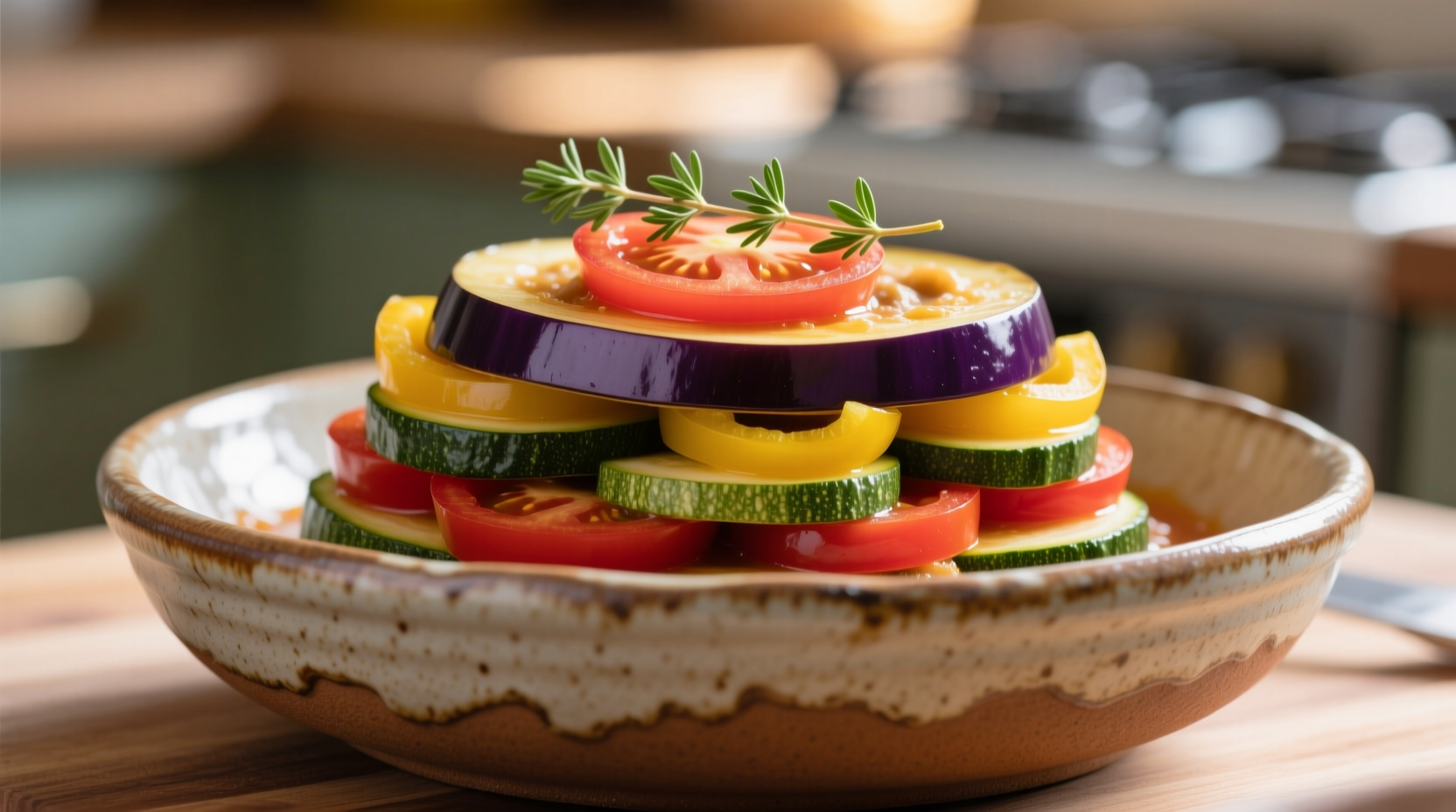Why This Ratatouille Method Delivers Authentic Flavor
Most online recipes misrepresent ratatouille as a baked casserole, but the true Provençal version involves individually cooking each vegetable before combining them. This technique preserves distinct textures while allowing flavors to meld. As Sophie Dubois explains from her French culinary training: "The magic happens when you treat each vegetable as its own component first—eggplant absorbs oil differently than zucchini, and tomatoes release moisture at different rates. Rushing this process creates mush."
Traditional Ratatouille vs. Modern Interpretations
| Preparation Method | Traditional Ratatouille | Confite Byaldi (Movie Version) |
|---|---|---|
| Cooking Technique | Stovetop simmering | Oven-baked layers |
| Preparation Time | 2 hours | 1.5 hours |
| Texture Profile | Distinct vegetable textures | Uniform tender layers |
| Flavor Development | Deep, complex melding | Clear individual notes |
Essential Equipment Checklist
- Cast iron or heavy-bottomed Dutch oven (critical for even heat distribution)
- Sharp chef's knife for consistent 1/4-inch slices
- Mandoline slicer (optional but recommended for uniform thickness)
- Paper towels for moisture control
Ingredient Selection Guide: Quality Matters
Authentic ratatouille depends on seasonal summer vegetables at their peak. In Provence, farmers use specific varieties:
- Eggplant: Barbarella variety (less bitter, thinner skin) - salt and drain for 30 minutes
- Zucchini: Ronde de Nice (firmer texture) - avoid oversized specimens
- Tomatoes: Coeur de Boeuf (meaty with less water content)
- Peppers: Cornille d'Alep (sweet, tapered) - substitute cubanelle if unavailable
- Olive oil: Extra virgin from Provence (minimum 1/2 cup for proper cooking)
Traditional Preparation Timeline
Ratatouille evolved from humble peasant food in 18th century Nice. Historical records from the French National Research Institute for Agriculture show how Provençal cooks developed this layered cooking method to maximize scarce olive oil:
- Prep (45 min): Slice vegetables uniformly, salt eggplant, prepare aromatics
- Cook vegetables separately (60 min): Sauté each vegetable type individually
- Layer and simmer (30 min): Build layers in Dutch oven with tomato base
- Rest (overnight): Essential for flavor development (traditional method)
Step-by-Step Cooking Process
Follow this authentic method for restaurant-quality results:
Vegetable Preparation
Cut all vegetables into 1/4-inch rounds using consistent thickness. Place eggplant slices between paper towels with coarse salt for 30 minutes to remove bitterness, then rinse and pat dry thoroughly. This moisture control prevents oil splatter and soggy texture.
Cooking Each Component
Heat 1/4 cup olive oil in Dutch oven over medium heat:
- Cook eggplant in single layer until golden (3-4 min per side), repeating with fresh oil as needed
- Prepare zucchini similarly, but cook only 2-3 minutes per side
- Sauté onions and garlic until translucent
- Make tomato base: Cook diced tomatoes with herbs de Provence 15 minutes until thickened
Layering Technique
Build flavor layers in this order:
- Tomato base (1/3 of mixture)
- Alternate vegetable slices in concentric circles
- Repeat layers twice more
- Top with remaining tomato base and fresh herbs
Simmering and Resting
Cover and simmer on lowest heat 30 minutes. Remove lid and cook 15 more minutes. Critical step: Let rest overnight before serving. This allows flavors to fully integrate—a technique documented in La Bonne Cuisine Provençale (1930) that transforms the dish.

Common Mistakes to Avoid
- Skipping vegetable pre-cooking: Creates uneven texture and watery sauce
- Using watery tomatoes: Leads to soggy final product (drain excess liquid)
- Serving immediately: Authentic flavor develops after 24-hour rest period
- Overcrowding the pan: Causes steaming instead of proper sautéing
Serving Suggestions and Storage
Traditional ratatouille serves as both main course and flavor base. For best results:
- Bring to room temperature before serving (never cold from fridge)
- Garnish with fresh basil and high-quality olive oil
- Pair with crusty bread to soak up flavorful juices
- Store in airtight container up to 5 days—flavor improves on day 2
- Freeze portions for up to 3 months (thaw overnight before reheating)
Troubleshooting Guide
Address these common issues:
- Too watery: Simmer uncovered 10-15 minutes to reduce liquid
- Bland flavor: Add 1 tsp tomato paste while cooking tomato base
- Mushy texture: Reduce simmer time and ensure proper vegetable thickness
- Bitter eggplant: Increase salting time to 45 minutes before cooking











 浙公网安备
33010002000092号
浙公网安备
33010002000092号 浙B2-20120091-4
浙B2-20120091-4